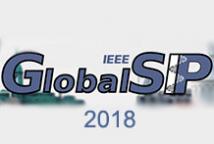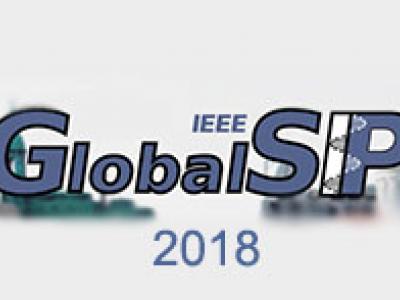
The 6th IEEE Global Conference on Signal and Information Processing (GlobalSIP) focuses on signal and information processing with an emphasis on up-and-coming signal processing themes. The conference features world-class plenary speeches, distinguished symposium talks, tutorials, exhibits, oral and poster sessions, and panels. GlobalSIP is comprised of co-located General Symposium and symposia selected based on responses to the call-for-symposia proposals.

- Read more about Fast phase-difference-based DoA estimation using random ferns
- Log in to post comments
- Categories:
 11 Views
11 Views
- Read more about PREDICTION-BASED SIMILARITY IDENTIFICATION FOR AUTOREGRESSIVE PROCESSES
- Log in to post comments
- Categories:
 4 Views
4 Views
- Categories:
 34 Views
34 Views
In this paper, we propose a robust analog-only beamforming scheme for the downlink multi-user systems, which not only suppresses the interference and enhances the beamform- ing gain, but also provides robustness against imperfect channel state information (CSI). We strike a balance between the average beamforming gain and the inter-user interference by formulating a multi-objective problem. A probabilistic objective of leakage interference power is formulated to alleviate the effects of the channel estimation and feedback quantization errors.
- Categories:
 65 Views
65 Views
- Read more about Reconstruction-free deep convolutional neural networks for partially observed images
- Log in to post comments
Conventional image discrimination tasks are performed on fully observed images. In challenging real imaging scenarios, where sensing systems are energy demanding or need to operate with limited bandwidth and exposure-time budgets, or defective pixels, where the data collected often suffers from missing information, and this makes the task extremely hard. In this paper, we leverage Convolutional Neural Networks (CNNs) to extract information from partially observed images.
- Categories:
 17 Views
17 Views
- Read more about Generalized Approximate Message Passing for Unlimited Sampling of Sparse Signals
- Log in to post comments
In this paper we consider the generalized approxi- mate message passing (GAMP) algorithm for recovering a sparse signal from modulo samples of randomized projections of the unknown signal. The modulo samples are obtained by a self-reset (SR) analog to digital converter (ADC). Additionally, in contrast to previous work on SR ADC, we consider a scenario where the compressed sensing (CS) measurements (i.e., randomized projections) are sent through a communication channel, namely an additive white Gaussian noise (AWGN) channel before being quantized by a SR ADC.
- Categories:
 8 Views
8 Views
- Read more about Downlink Spectral Efficiency of Cell-Free Massive MIMO with Full-Pilot Zero-Forcing
- Log in to post comments
Cell-free Massive multiple-input multiple-output
(MIMO) ensures ubiquitous communication at high spectral
efficiency (SE) thanks to increased macro-diversity as compared
cellular communications. However, system scalability and performance
are limited by fronthauling traffic and interference.
Unlike conventional precoding schemes that only suppress intra-cell
interference, full-pilot zero-forcing (fpZF), introduced in [1],
actively suppresses also inter-cell interference, without sharing
- Categories:
 29 Views
29 Views
- Read more about Zeroth-Order Stochastic Projected Gradient Descent for Nonconvex Optimization
- Log in to post comments
- Categories:
 37 Views
37 Views
- Read more about A HYBRID NEURAL NETWORK FRAMEWORK AND APPLICATION TO RADAR AUTOMATIC TARGET RECOGNITION
- Log in to post comments
Deep neural networks (DNNs) have found applications in diverse signal processing (SP) problems. Most efforts either directly adopt the DNN as a black-box approach to perform certain SP tasks without taking into account of any known properties of the signal models, or insert a pre-defined SP operator into a DNN as an add-on data processing stage. This paper presents a novel hybrid-NN framework in which one or more SP layers are inserted into the DNN architecture in a coherent manner to enhance the network capability and efficiency in feature extraction.
- Categories:
 10 Views
10 Views
- Read more about StationPlot: A New Non-stationarity Quantification Tool for Detection of Epileptic Seizures
- Log in to post comments
A novel non-stationarity visualization tool known as StationPlot is developed for deciphering the chaotic behavior of a dynamical time series. A family of analytic measures enumerating geometrical aspects of the non-stationarity & degree of variability is formulated by convex hull geometry (CHG) on StationPlot. In the Euclidean space, both trend-stationary (TS) & difference-stationary (DS) perturbations are comprehended by the asymmetric structure of StationPlot's region of interest (ROI).
- Categories:
 34 Views
34 Views